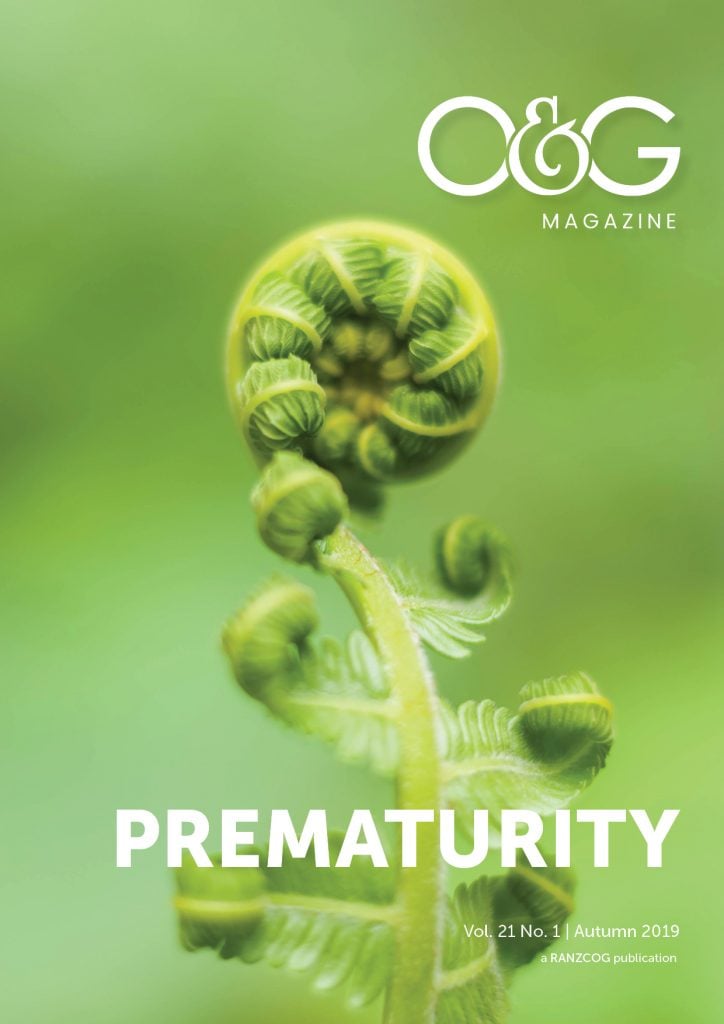The impact of antenatal corticosteroids in improving neonatal outcomes for preterm infants has been heralded as one of the greatest medical advances of the 20th century; so much so that the logo for the Cochrane Collaboration represents the forest plot of the Crowley systematic review of the benefits of antenatal corticosteroids1 with the Cochrane Collaboration stating that ‘this simple intervention has probably saved thousands of premature babies’.2 Strong evidence exists for the benefit of a single dose of antenatal corticosteroids in reducing the rates of neonatal death, respiratory distress syndrome (RDS), intraventricular haemorrhage, early neonatal sepsis and necrotising enterocolitis in preterm infants.3 However, for an intervention that is used almost daily across maternity units in Australia and New Zealand, controversies exist for its use in many common situations such as, the use of repeat doses, the use of antenatal corticosteroids in the late preterm period and the use of antenatal corticosteroids in special populations, such as in women with diabetes.
Repeat doses of antenatal corticosteroids
The ACTORDS trial, an Australasian trial that randomised women who had already received a single dose of antenatal corticosteroids and who remained at risk of preterm delivery to either repeated doses of antenatal corticosteroids or placebo, demonstrated that neonates exposed to repeated doses of antenatal corticosteroids had lower rates of RDS, required less need for, and duration of, oxygen therapy and had a shorter duration of mechanical ventilation.4 Although z scores for birthweight and head circumference were significantly lower at birth in those exposed to repeated doses of antenatal corticosteroids, no differences were seen in anthropometric measurements or z scores at hospital discharge. In contrast, the National Institute of Child Health and Human Development (NIHCD) study, which investigated the impact of repeat doses of antenatal corticosteroids, was terminated early due to statistically significant reductions in birthweight and an increase in the rate of small for gestational age babies in those exposed to repeated courses of antenatal corticosteroids.5 Despite this, in the 495 patients that were enrolled in the trial, repeated courses of antenatal corticosteroids were associated with significantly reduced rates of mechanical ventilation, pneumothoraces and surfactant administration.6
The Cochrane review, which included 10 trials, confirmed the reduction in the risk of RDS and combined serious neonatal outcome with repeated doses, but did note reductions in mean weight, head circumference and length that were not seen when adjusted for gestational age.7 This review found that there was no evidence of either significant benefit or harm at two to three year follow up, concluding that treatment with repeat courses of antenatal corticosteroids should be considered and that women should receive detailed counselling regarding the benefits, risks and limited information on long-term outcomes.8
The long-term data, reporting outcomes at age six to eight, has been largely reassuring. No differences have been elicited in neonatal hypothalamus-pituitary-adrenal axis suppression, cardiometabolic outcomes, functional residual capacity of the lung, or bone mass in those exposed to antenatal corticosteroids compared to those who were not.9 10 11 12 13 Concerns have been raised in the two-year follow up of the ACTORDS trial, with children exposed to repeat doses of corticosteroids more likely to require assessment for attention problems.14 Follow up of the NIHCD study also revealed a non-significant increase in cerebral palsy in neonates exposed to four to five doses of antenatal corticosteroids and born after 34 weeks, compared with neonates exposed to only one dose of antenatal corticosteroid.15
While these data do not detract from the significant benefits of antenatal corticosteroids in terms of reductions in neonatal death and need for mechanical ventilation in preterm infants, they do raise a note of caution with respect to the overuse of antenatal corticosteroids in cases at lower risk of preterm birth.
International guidance for clinicians regarding the use of repeat doses of antenatal corticosteroids varies, with the ACOG guidelines recommending a single rescue course of antenatal corticosteroids in women who are greater than two weeks from their initial treatment, less than 32 weeks of gestational age and judged to be likely to give birth within the next week, while the NICE guideline recommends not routinely offering repeat courses unless deemed appropriate by the treating clinician.16 17 The Australia and New Zealand guideline recommends the use of repeat doses when preterm birth is planned or expected within the next seven days in a woman who has received a course of antenatal corticosteroids more than seven days ago and remains less than 32+6 weeks gestational age.18
Given these contradictory findings, it is not surprising to find that clinical guidelines used in Australian and New Zealand hospitals vary significantly.19 Uncertainty also remains with respect to the duration of coverage of corticosteroids, given the Australasian guidance of repeating doses every seven days contrasts with the US guidance suggesting that repeated doses are not required before 14 days. Although, the bulk of evidence for the beneficial effects of corticosteroids is seen when corticosteroids are administered within seven days of delivery, some beneficial impact is seen up to 14 days after administration.20
Antenatal corticosteroids in the late preterm period
The bulk of evidence for the benefits of antenatal corticosteroids exists for the early preterm period, although the majority of preterm deliveries, and eight per cent of all deliveries, occur in the late preterm period from 34+0 to 36+6 weeks gestation.21 The ‘Antenatal Betamethasone for Women at Risk of Preterm Delivery’ (ALPS) study reported short-term benefit in infants exposed to antenatal corticosteroids, with a 20 per cent risk reduction in the composite primary neonatal outcome, which included neonatal respiratory support, stillbirth or neonatal death up to 72 hours after birth.22 Significantly decreased rates of transient tachypnoea, surfactant use and bronchopulmonary dysplasia were also seen in the betamethasone group, although the rate of neonatal hypoglycaemia was significantly increased in this group.23 No differences were seen in the maternal outcomes between the two groups, including mode of delivery, rates of chorioamnionitis or endometritis.
Although these results seem promising, the potential benefits and the generalisability to our population remain uncertain. Firstly, there were no significant differences between the rates of RDS or NICU admission between the two groups; the majority of the respiratory morbidity reported was secondary to transient tachypnea of the newborn, a generally mild and self-limiting condition.24 The trial excluded women with multiple pregnancies and pre-gestational diabetes; two groups in which the risk of late preterm delivery, and subsequent respiratory morbidity, is high.25 26 The strict inclusion criteria of the trial led to over 80 per cent of the trial population, in both groups, delivering prior to 36+6 weeks gestation, a feat seldom reproducible in daily practice.27 Furthermore, the trial has yet to report on the long-term outcomes and the impact of the increased rates of neonatal hypoglycaemia, which are especially concerning as even transient neonatal hypoglycaemia has been associated with long-term adverse outcomes, including decreased proficiency in literacy and mathematical achievement tests.28
Once again, international guidance on this issue varies. ACOG embraced the results of the ALPS trial and recommend a single course of betamethasone for a woman at risk of preterm birth within seven days between 34+0 and 36+6 weeks gestation, who have not received a previous course of antenatal corticosteroids.29 The NICE guideline recommends consideration of a course of antenatal corticosteroids for a woman at risk of preterm labour or having a planned preterm birth up to 35+6 weeks gestation.30 Currently, the Australia and New Zealand guideline only recommends antenatal corticosteroids up to 34+6 weeks gestation, except in circumstances of an elective caesarean section prior to 39+0 weeks when lung immaturity is known.31 Defining lung immaturity antenatally is not a simple task and amniocentesis for lecithin sphingomyelin is rarely performed in Australia and New Zealand.
Conclusion
Despite the considerable data supporting the use of antenatal corticosteroids in the preterm period, controversies remain regarding the optimal frequency of administration, the latest gestation for administration and the role of corticosteroids in specific groups, such as women with diabetes. Moreover, while long-term data are mostly reassuring, subtle neurocognitive findings that are emerging from the ACTORDS and ASTECS follow-up studies suggest the need for a more cautious approach with respect to expanded indications and frequency of administration of antenatal corticosteroids, particularly in those who do not ultimately go on to deliver in the preterm period.32 33 Further prospective research is required to understand the short- and long-term outcomes of antenatal corticosteroids in the preterm period in special populations such as multiple pregnancies, women with diabetes34 and in the late pre-term period between 34+6 and 36+6 weeks.
Although the obstetric profession was previously criticised for not embracing the benefits of antenatal corticosteroids with enthusiasm, perhaps now is the time for a more considered approach regarding the expanding indications for administration. After all, as Greek philosopher Epictetus theorised, ‘If one oversteps the bounds of moderation, even the greatest pleasures cease to please’.
References
- Crowley PA. Antenatal corticosteroids therapy: A meta-analysis of the randomized trials, 1972 to 1994. Am J Obstet Gynecol. 1995;173(1):322-35.
- Library TC. The Difference We Make. [cited December 2018]. Available from: www.cochrane.org/about-us/difference-we-make.
- Roberts D, Brown J, Medley, N. Dalziel SR. Antenatal corticosteroids for accelerating fetal lung maturation for women at risk of preterm birth. Cochrane Database Syst Rev. 2017;3:CD004454.
- Crowther CA, Haslam RR, Hiller JE, et al. Neonatal respiratory distress syndrome after repeat exposure to antenatal corticosteroids: a randomised controlled trial. Lancet. 2006;367(9526):1913-9.
- Wapner RJ, Sorokin Y, Thom EA, et al. Single versus weekly courses of antenatal corticosteroids: evaluation of safety and efficacy. Am J Obstet Gynecol. 2006;195(3):633-42.
- Wapner RJ, Sorokin Y, Thom EA, et al. Single versus weekly courses of antenatal corticosteroids: evaluation of safety and efficacy. Am J Obstet Gynecol. 2006;195(3):633-42.
- Crowther CA, McKinlay CJ, Middleton P, Harding JE. Repeat doses of prenatal corticosteroids for women at risk of preterm birth for improving neonatal health outcomes. Cochrane Database Syst Rev. 2015;(7):CD003935.
- Crowther CA, McKinlay CJ, Middleton P, Harding JE. Repeat doses of prenatal corticosteroids for women at risk of preterm birth for improving neonatal health outcomes. Cochrane Database Syst Rev. 2015;(7):CD003935.
- Battin MR, Bevan C, Harding JE. Repeat doses of antenatal steroids and hypothalamic-pituitary-adrenal axis (HPA) function. Am J Obstet Gynecol. 2007;197(1):40 e1-6.
- Cartwright RD, Harding JE, Crowther CA, et al. Repeat Antenatal Betamethasone and Cardiometabolic Outcomes. Pediatrics. 2018;142(1).
- McEvoy C BS, Williamson K, Lozano D, et al. The Effect of a Single Remote Course Versus Weekly Courses of Antenatal Corticosteroids on Functional Residual Capacity in Preterm Infants: A Randomised Trial. Pediatrics. 2002;(110):280-4.
- McKinlay CJD, Cutfield WS, Battin MR, et al. Cardiovascular Risk Factors in Children After Repeat Doses of Antenatal Glucocorticoids: An RCT. Pediatrics. 2015;135(2):e405-15.
- McKinlay CJD, Cutfield WS, Battin MR, et al. Mid-Childhood Bone Mass After Exposure to Repeat Doses of Antenatal Glucocorticoids: A Randomized Trial. Pediatrics. 2017;139(5).
- Crowther CA, Doyle LW, Haslam RR, et al, for the ACTORDS Study Group. Outcomes at 2 Years of Age after Repeat Doses of Antenatal Corticosteroids. N Engl J Med. 2007;357(12):1179-89.
- Wapner RJ YS, Mele L, Johnson F, et al. Long-Term Outcomes after Repeat Doses of Antenatal Corticosteroids. N Engl J Med. 2007;357:1190-8.
- ACOG. Committee Opinion Number 677: Antenatal Corticosteroid Therapy for Fetal Lung Maturation. Obsterics and Gynecology. 2016;128:e187–94.
- National Institute of Health and Care Excellence. Preterm labour and birth. 2015.
- Antenatal corticosteroids given to women prior to birth to improve fetal, infant, child and adult health: Clinical practice guidelines. Auckland: Liggins Institute, The University of Auckland; 2015.
- McGoldrick EL, Brown JA, Groom KM, Crowther CA. Investigating antenatal corticosteroid clinical guideline practice at an organisational level. ANZJOG. 2017;57(1):25-32.
- Wilms FF, Vis JY, Pattinaja DA, et al. Relationship between the time interval from antenatal corticosteroid administration until preterm birth and the occurrence of respiratory morbidity. Am J Obstet Gynecol. 2011;205(1):49 e1-7.
- Souter V, Kauffman E, Marshall AJ, Katon JG. Assessing the potential impact of extending antenatal steroids to the late preterm period. Am J Obstet Gynecol. 2017;217(4):461 e1- e7.
- Gyamfi-Bannerman C, Thom EA, Blackwell SC, et al. Antenatal Betamethasone for Women at Risk for Late Preterm Delivery. N Engl J Med. 2016;374(14):1311-20.
- Gyamfi-Bannerman C, Thom EA, Blackwell SC, et al. Antenatal Betamethasone for Women at Risk for Late Preterm Delivery. N Engl J Med. 2016;374(14):1311-20.
- Gyamfi-Bannerman C, Thom EA, Blackwell SC, et al. Antenatal Betamethasone for Women at Risk for Late Preterm Delivery. N Engl J Med. 2016;374(14):1311-20.
- Fung GPG, Chan LM, Ho YC, et al. Does gestational diabetes mellitus affect respiratory outcome in late-preterm infants? Early Human Development. 2014;90(9):527-30.
- Becquet O, El Khabbaz F, Alberti C, et al. Insulin treatment of maternal diabetes mellitus and respiratory outcome in late-preterm and term singletons. BMJ Open. 2015;5(6):e008192.
- Gyamfi-Bannerman C, Thom EA, Blackwell SC, et al. Antenatal Betamethasone for Women at Risk for Late Preterm Delivery. N Engl J Med. 2016;374(14):1311-20.
- Kaiser JR, Bai S, Gibson N, et al. Association between transient newborn hypoglycemia and fourth-grade achievement test proficiency: A population-based study. JAMA Pediatrics. 2015;169(10):913-21.
- ACOG. Committee Opinion Number 677: Antenatal Corticosteroid Therapy for Fetal Lung Maturation. Obsterics and Gynecology. 2016;128:e187–94.
- National Institute of Health and Care Excellence. Preterm labour and birth. 2015.
- Antenatal corticosteroids given to women prior to birth to improve fetal, infant, child and adult health: Clinical practice guidelines. Auckland: Liggins Institute, The University of Auckland; 2015.
- Crowther CA, Doyle LW, Haslam RR, et al, for the ACTORDS Study Group. Outcomes at 2 Years of Age after Repeat Doses of Antenatal Corticosteroids. N Engl J Med. 2007;357(12):1179-89.
- Stutchfield PR, Whitaker R, Gliddon AE, et al. Behavioural, educational and respiratory outcomes of antenatal betamethasone for term caesarean section (ASTECS trial). Archives of Disease in Childhood – Fetal and Neonatal Edition. 2013;98(3):F195-F200.
- Amiya RM, Mlunde LB, Ota E, et al. Antenatal Corticosteroids for Reducing Adverse Maternal and Child Outcomes in Special Populations of Women at Risk of Imminent Preterm Birth: A Systematic Review and Meta-Analysis. PLoS ONE. 2016;11(2):e0147604.






Leave a Reply